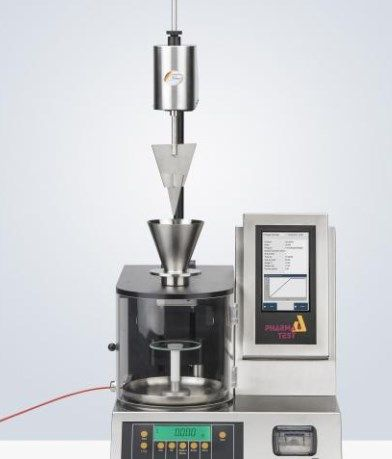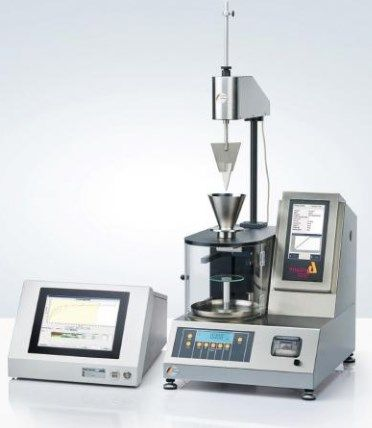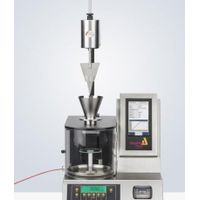Pharmatest USA - Powder Flow Analyzer with NIR
Manufactured by Pharmatest USA
PTG-NIR - Powder Analysis System> The PTG-NIR automatic powder and granule...
PTG-NIR - Powder Analysis System
The PTG-NIR automatic powder and granule analysis system combines the Pharma Test PTG-S5 powder flow testing instrument with an integrated J&M TIDAS L NIR diode array spectrometer. The system is controlled by the powerful TIDASDAQ3 software including a customized script for the PTG-NIR. The system is ideal to examine the flow characteristics of a powder or granule. This combination is ideal for simultaneous detection of chemical, physical and morphological information. This information is describing the flow behaviors of a powder or granule. Other forms of solids are possible to be tested too. All the results are presented in a single report generated by the included TIDASDAQ3 software.
Construction of the System
The automated PTG-S5 stand-alone powder characterization system is used to measure the flow behavior of granules and powders in compliance with the EP and USP Pharmacopoeia. In addition the instrument is also compliant to the ISO 4324 and DIN EN 12047 standards. It features an integrated balance and a built-in printer for a compact foot print. The GMP compliant all stainless steel finish is easy to clean and maintain.
The J&M TIDAS L NIR diode array spectrometer is built-into a separate stainless steel housing from which the fiber optic cable is directly connected to the PTG-S5 instrument. This combination is the PTG-NIR. The NIR measurement accessory greatly expands the application range of the standard PTG-S5 instrument.
Expanded Range of Application
The PTG-NIR is equipped with a J&M NIR diode array spectrometer. A fiber optic probe is swiveled in just below the transparent glass powder dish of the PTG-S5 instrument. The NIR measurement is made by shining the light through the probe window and the glass powder dish, directly into the powder cone that forms on the powder dish. The light penetrates the powder cone enough to provide reproducible spectral results.
By adding the NIR spectrometer the range of application is expanded for the additional analysis of:
Moisture content
API concentration
Qualitative “finger printing” of powder content
Homogeneity of blended components
Blends of non-active materials can also be analyzed. The system can also shed light on the distribution of an API within a powder blend. It is possible to develop methods to give indications for content uniformity.
Operating Principle of the PTG-S5 Powder Flow Analyzer
The PTG-S5 is widely used to compare batches of powders perhaps supplied by the same manufacturer over a period of time or for similar materials provides by different suppliers. The flow characteristics can be easily and quickly determined as a QC tool for inter- batch reproducibility, as this may have a distinct bearing on the ease of production especially if powders are capable of agglomeration and cohesion over time.
A conical funnel, which can be equipped with different pouring nozzles, takes the sample to be tested. A built-in analytical Sartorius balance cell takes the product collecting dish. The PTG-ER electrical stirrer may be used for powders, which do not flow well. Most pharmaceutical material contains such a high amount of fine particles that it will not start to flow without assistance.
Enter product information using the alphanumeric keyboard of the instrument. The method parameters are automatically transmitted to the TIDASDAQ3 software. Select the test program you want to use:
Flow time
Cone angle
Volume
Flow-chart
Density
Flowability
Then start the test. Depending on the powder the PTG-ER stirrer may be used. When the test is started the funnel is opened and two IR sensors detect the powder flow, this will start the timer to measure the flow time and to record the flow chart. The product itself is collected on a 100mm diameter dish and forms a cone. Once the powder flow stops, the funnel is closed and the movable measuring arm which holds the two infra-red sensors starts to measure the height of the cone up to the tip. Since the surface of the collecting dish is completely filled, the cone angle can be calculated and displayed.
The test should be repeated (in accordance to the ISO 4324 five times) and the deviation of results should not exceed 5%. The test results are displayed at the LCD display of the PTG-S5 and the TIDASDAQ3 software. Using the built-in thermal printer a test report and powder flow-chart will be printed including descriptive information of the product. Furthermore a PDF report is generated by TIDASDAQ3.
To measure the flowability as per EP and USP Pharmacopoeia the test is automatically stopped as soon as 100mg of sample have been collected inside a suitable plastic beaker. In addition to the flowability factor (100mg/t) the powder flow chart can be printed.
The standard instrument comes with all attachments to measure flow-time, cone angle and flowability in compliance to the current EP/USP Pharmacopoeia. Different pouring nozzles from 4 – 10 mm can be used to test the product. A stirrer can be used to force non-flowing product through the selected pouring nozzle.
The PTG-S5 powder testing system includes a built-in analytical Sartorius balance cell, which extends the instrument use to test powder flowability, density and volume. Additionally, a graph can be plotted on the built-in printer showing the flow behavior of the sample under test. Using the conical stainless steel funnel as described in the current EP/USP monograph and use the changeable nozzles of 10, 15 and 25mm, the cone angle can also be tested. If smaller diameter nozzles are to be used, an adapter ring which allows the use of pouring nozzles from 4 to 10mm is available.
Up to 10 tests can be performed and used to calculate statistics including mean values of all selected test parameters. The data and results are displayed on the LC-display, presented as hard copy on the built-in printer and transmitted via RS-232 interface to the TIDASDAQ3 data acquisition software.
The PTG-NIR automatic powder and granule analysis system combines the Pharma Test PTG-S5 powder flow testing instrument with an integrated J&M TIDAS L NIR diode array spectrometer. The system is controlled by the powerful TIDASDAQ3 software including a customized script for the PTG-NIR. The system is ideal to examine the flow characteristics of a powder or granule. This combination is ideal for simultaneous detection of chemical, physical and morphological information. This information is describing the flow behaviors of a powder or granule. Other forms of solids are possible to be tested too. All the results are presented in a single report generated by the included TIDASDAQ3 software.
Construction of the System
The automated PTG-S5 stand-alone powder characterization system is used to measure the flow behavior of granules and powders in compliance with the EP and USP Pharmacopoeia. In addition the instrument is also compliant to the ISO 4324 and DIN EN 12047 standards. It features an integrated balance and a built-in printer for a compact foot print. The GMP compliant all stainless steel finish is easy to clean and maintain.
The J&M TIDAS L NIR diode array spectrometer is built-into a separate stainless steel housing from which the fiber optic cable is directly connected to the PTG-S5 instrument. This combination is the PTG-NIR. The NIR measurement accessory greatly expands the application range of the standard PTG-S5 instrument.
Expanded Range of Application
The PTG-NIR is equipped with a J&M NIR diode array spectrometer. A fiber optic probe is swiveled in just below the transparent glass powder dish of the PTG-S5 instrument. The NIR measurement is made by shining the light through the probe window and the glass powder dish, directly into the powder cone that forms on the powder dish. The light penetrates the powder cone enough to provide reproducible spectral results.
By adding the NIR spectrometer the range of application is expanded for the additional analysis of:
Blends of non-active materials can also be analyzed. The system can also shed light on the distribution of an API within a powder blend. It is possible to develop methods to give indications for content uniformity.
The PTG-S5 is widely used to compare batches of powders perhaps supplied by the same manufacturer over a period of time or for similar materials provides by different suppliers. The flow characteristics can be easily and quickly determined as a QC tool for inter- batch reproducibility, as this may have a distinct bearing on the ease of production especially if powders are capable of agglomeration and cohesion over time.
A conical funnel, which can be equipped with different pouring nozzles, takes the sample to be tested. A built-in analytical Sartorius balance cell takes the product collecting dish. The PTG-ER electrical stirrer may be used for powders, which do not flow well. Most pharmaceutical material contains such a high amount of fine particles that it will not start to flow without assistance.
Enter product information using the alphanumeric keyboard of the instrument. The method parameters are automatically transmitted to the TIDASDAQ3 software. Select the test program you want to use:
Then start the test. Depending on the powder the PTG-ER stirrer may be used. When the test is started the funnel is opened and two IR sensors detect the powder flow, this will start the timer to measure the flow time and to record the flow chart. The product itself is collected on a 100mm diameter dish and forms a cone. Once the powder flow stops, the funnel is closed and the movable measuring arm which holds the two infra-red sensors starts to measure the height of the cone up to the tip. Since the surface of the collecting dish is completely filled, the cone angle can be calculated and displayed.
The test should be repeated (in accordance to the ISO 4324 five times) and the deviation of results should not exceed 5%. The test results are displayed at the LCD display of the PTG-S5 and the TIDASDAQ3 software. Using the built-in thermal printer a test report and powder flow-chart will be printed including descriptive information of the product. Furthermore a PDF report is generated by TIDASDAQ3.
To measure the flowability as per EP and USP Pharmacopoeia the test is automatically stopped as soon as 100mg of sample have been collected inside a suitable plastic beaker. In addition to the flowability factor (100mg/t) the powder flow chart can be printed.
The standard instrument comes with all attachments to measure flow-time, cone angle and flowability in compliance to the current EP/USP Pharmacopoeia. Different pouring nozzles from 4 – 10 mm can be used to test the product. A stirrer can be used to force non-flowing product through the selected pouring nozzle.
The PTG-S5 powder testing system includes a built-in analytical Sartorius balance cell, which extends the instrument use to test powder flowability, density and volume. Additionally, a graph can be plotted on the built-in printer showing the flow behavior of the sample under test. Using the conical stainless steel funnel as described in the current EP/USP monograph and use the changeable nozzles of 10, 15 and 25mm, the cone angle can also be tested. If smaller diameter nozzles are to be used, an adapter ring which allows the use of pouring nozzles from 4 to 10mm is available.
Up to 10 tests can be performed and used to calculate statistics including mean values of all selected test parameters. The data and results are displayed on the LC-display, presented as hard copy on the built-in printer and transmitted via RS-232 interface to the TIDASDAQ3 data acquisition software.
Active Questions & AnswersAsk a Question
There are no current Discussions
Powder Testing Service ProvidersView All (9)
Documents & Manuals
There are no Documents or Manuals available.
Features
There are no Features available.
General Specifications
There are no General Specifications available.




